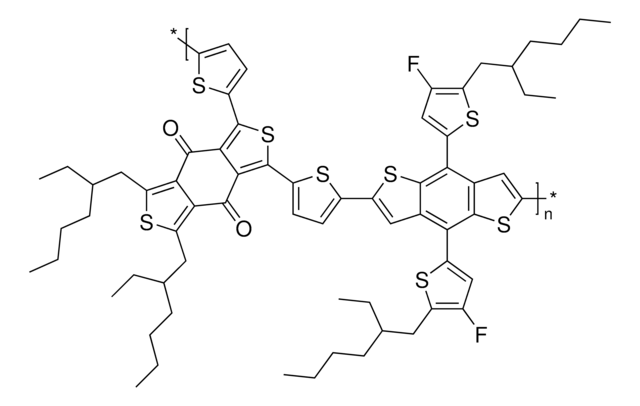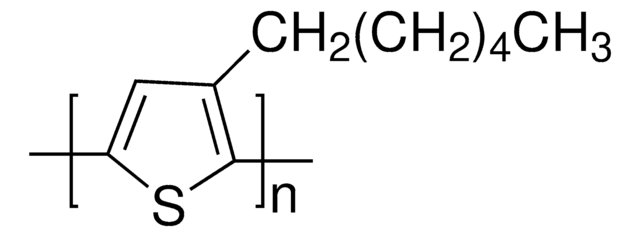684465
[6,6]-Phenyl C71 butyric acid methyl ester
99%
Sinonimo/i:
3′H-Cyclopropa[8,25] [5,6]fullerene-C70-D5h(6)-3′butanoic acid, 3′Phenyl-3′H-cyclopropa[8,25] [5,6]fullerene-C70-D5h(6)-3′butanoic acid, methyl ester, [70]PCBM
About This Item
Prodotti consigliati
Livello qualitativo
Saggio
99%
Stato
powder
Solubilità
chlorobenzene: soluble
organic solvents: soluble
toluene: soluble
Energia dell’orbitale
HOMO 6 eV
LUMO 3.9 eV
Caratteristiche del semiconduttore
N-type (mobility=0.1 cm2/V·s)
Stringa SMILE
COC(=O)CCCC2(c1ccccc1)C34c5c6ccc7c8cc9Cc%10cc%11cc%12Cc%13cc%14c%15ccc6c3c%15c%16c%17c%18c%19c(c(c57)c8c%20c9c%10c%21c%11c%22c%12c%13c(c%14%16)c%18c%22c%21c%19%20)C24%17
Descrizione generale
Applicazioni
Codice della classe di stoccaggio
11 - Combustible Solids
Classe di pericolosità dell'acqua (WGK)
WGK 3
Punto d’infiammabilità (°F)
Not applicable
Punto d’infiammabilità (°C)
Not applicable
Dispositivi di protezione individuale
dust mask type N95 (US), Eyeshields, Gloves
Scegli una delle versioni più recenti:
Possiedi già questo prodotto?
I documenti relativi ai prodotti acquistati recentemente sono disponibili nell’Archivio dei documenti.
I clienti hanno visto anche
Articoli
Since the first publication in 1995 describing a bulk heterojunction photodiode incorporating a methanofullerene, significant progress has been made in improving device performance and the scope of device research has broadened widely.
The field of organic electronics has emerged as the next-generation technology potentially enabling ultra-thin, large-area, and/or flexible devices, consisting of organic field-effect transistors (OFETs), organic light-emitting diodes (OLEDs), and organic photovoltaics (OPVs).
PCBM-based n-type semiconductors - Find p- and n-type organic semiconductors available with PCBM library & properties.
The emerging organic photovoltaic (OPV) technology is very promising for low-cost solar energy production. OPV devices can be produced using high-throughput, large-volume printing methods on lightweight and flexible plastic substrates, making them easy to deploy and use in innovative ways.
Il team dei nostri ricercatori vanta grande esperienza in tutte le aree della ricerca quali Life Science, scienza dei materiali, sintesi chimica, cromatografia, discipline analitiche, ecc..
Contatta l'Assistenza Tecnica.![[6,6]-Phenyl C61 butyric acid methyl ester ≥99%](/deepweb/assets/sigmaaldrich/product/structures/359/221/d990c746-0960-4c69-bf76-fe09b193824d/640/d990c746-0960-4c69-bf76-fe09b193824d.png)






![1,1′-[4,8-Bis[5-(2-ethylhexyl)-2-thienyl]benzo[1,2-b:4,5-b′]dithiophene-2,6-diyl]bis[1,1,1-trimethylstannane]](/deepweb/assets/sigmaaldrich/product/structures/611/912/a638a6fe-ca7b-4674-8023-df4c0921a9fd/640/a638a6fe-ca7b-4674-8023-df4c0921a9fd.png)
